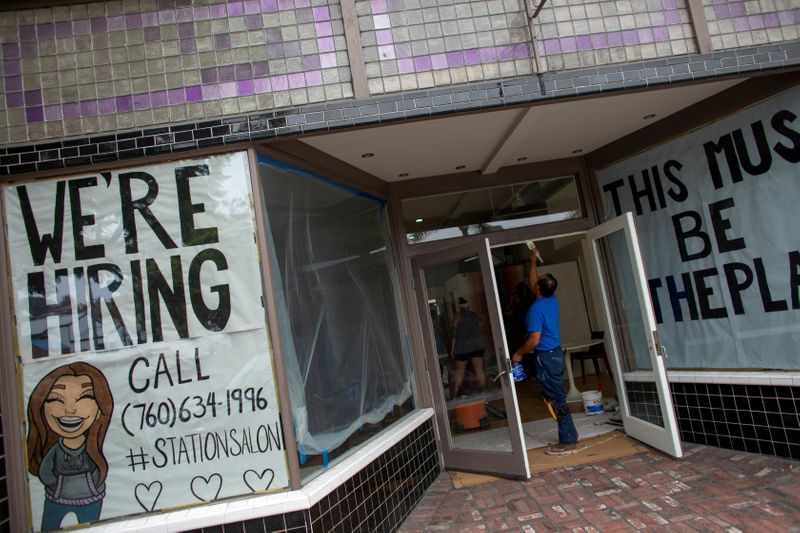By Lucia Mutikani
WASHINGTON (Reuters) - U.S. private payrolls increased less than expected in October and activity in the services industry cooled, providing early signs of a slowdown in economic growth as fiscal stimulus diminishes and new COVID-19 infections surge across the country.
The recovery from the coronavirus pandemic could also be impacted over the next few months by political uncertainty following Tuesday's cliffhanger presidential election, which economists warned could cause businesses to be more cautious about spending decisions.
The election hung in the balance on Wednesday, with a handful of close-fought states set to decide the outcome in the coming hours or days. There are fears of a contested result between President Donald Trump and his Democratic rival Joe Biden, who both still have possible paths to reach the needed 270 Electoral College votes to win the White House.
"This is not a good outcome for the economy since the headwinds from rising Covid cases, troubled state and local government finances and falling incomes as unemployment benefits expire, are growing in strength," said James Knightley, chief international economist at ING in New York.
"Animosity and the threat of legal challenges argues against a swift fiscal support package which will be a concern as activity becomes increasingly constrained."
Private payrolls increased by 365,000 jobs last month after rising 753,000 in September, the ADP National Employment Report showed on Wednesday. Economists polled by Reuters had forecast private payrolls would advance by 650,000 in October.
Job gains last month were broad, though they were concentrated in industries directly impacted by the coronavirus crisis, including the leisure and hospitality sector. The resurgence in COVID-19 cases across the country could lead to renewed business restrictions to slow the spread of the respiratory illness as winter approaches.
Even without new restrictions, Americans are likely to stay away from air travel, hotels, gyms, bars, restaurants and other consumer-facing businesses, worsening already lackluster demand, which has seen the labor market struggling to recoup all the 22.2 million jobs lost during the pandemic.
The ADP report is jointly developed with Moody's (NYSE:MCO) Analytics. Though it has fallen short of the government's private payrolls count since May because of methodology differences, it is still watched for clues on the labor market's health.
It was released ahead of the government's closely watched, and comprehensive, monthly employment report on Friday. According to a Reuters survey of economists, private nonfarm payrolls likely increased by 700,000 jobs in October after rising 877,000 in September.
With government payrolls expected to have dropped again last month as more temporary workers hired for the Census departed and state and local governments struggle with tight budgets, overall nonfarm payrolls are forecast increasing by 600,000 jobs after rising 661,000 in September. That would leave employment 10.1 million jobs below its peak in February.
GRIDLOCK
Surprisingly, U.S. financial markets were mostly higher despite the political uncertainty. Stocks on Wall Street rose. U.S. Treasury prices were higher. The dollar was steady against a basket of currencies.
"My sense is traders and investors are increasingly comfortable Republicans will hold the Senate and Democrats will hold the House," said Chris Low, chief economist at FHN Financial in New York. "From a markets standpoint, that means whoever emerges with White House control, Trump or Biden, will not be able to do much."
A survey from the Institute for Supply Management on Wednesday showed its non-manufacturing activity index fell to a reading of 56.6 in October from 57.8 in September, falling back below its 57.3 level in February.
The survey's measure of services industry employment slipped to 50.1 from a reading of 51.8 in September, consistent with views that the labor market was stalling after being boosted by more than $3 trillion in government pandemic relief for businesses and workers, which is now gone.
That is consistent with analysts' expectations for a step-down in economic growth in the fourth quarter after a historic 33.1% annualized rate of expansion in the third quarter. The economy contracted at a record 31.4% pace in the April-June quarter.
A third report from the Commerce Department showed the trade deficit fell 4.7% to $63.9 billion in September as food exports jumped to the highest level since July 2012, boosted by shipments of soybeans. Economists had forecast the trade shortfall narrowing to $63.8 billion in September.
Goods exports rose 3.1% to $122.8 billion, also lifted by telecommunications equipment, industrial engines and computer accessories. Exports to China were the highest since March 2018. New COVID-19 lockdowns in Europe could curb export gains.
Goods imports climbed 0.3% to $203.5 billion, the highest level since December 2019. Food imports were the highest on record in September. The nation also imported more capital goods, automotive vehicles, parts and engines.
Imports from China were the highest since July 2019. The United States imported 157.9 million barrels of crude oil in September, the fewest since February 1992.
